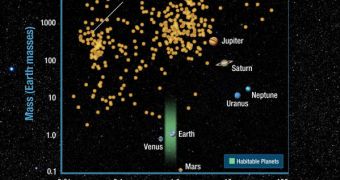In spite of the fact that our Sun allowed for, well, us to exist, astronomers have only recently come to the conclusion that Sun-like stars must be what we should be analyzing, when looking for alien life on other planets. One of the reasons why stars such as our own weren't considered the norm is the fact that we do not live around what experts would call a typical celestial body, Space reports.
“The principle of mediocrity says that, barring any evidence to the contrary, our observations should be typical among those of all intelligent observers. But the typical star is not like the Sun – the typical star is a low mass star. We don't find ourselves around a typical star and we show the reason why in this paper. Our results confirm the principle of mediocrity as applied to the Sun,” University of Louisiana at Lafayette researcher and physicist Daniel Whitmire says.
According to the most recent investigations, the perfect stars for sustaining intelligent life need to have about the mass of our own Sun, and temperatures between 9,100 and 10,300 degrees Fahrenheit, or about 5,300 to 6,000 Kelvin. Celestial bodies that meet this description are very few in the galaxy, astronomers believe. Surveys of the Milky Way have identified the fact that more than 93 percent of the billions of stars in the formation are smaller, dimmer and less warm than our Sun, which really narrows down the range of exoplanets that could be suspected of supporting water.
The experts who wrote the new study essentially wanted to give an estimate of how to find exoplanets capable of sustaining intelligent life. “It's a trade-off between the numbers of stars out there and the probability of habitable planet formation increasing with mass. We show it's no accident we find ourselves around a star like the Sun,” Whitmire explains. The experts add that hypothetical intelligent aliens would need to be on a planet around a star with a longer life span than it takes for intelligence to evolve. In the case of planet Earth, we took about 4.5 billion years to become smart.

 14 DAY TRIAL //
14 DAY TRIAL //